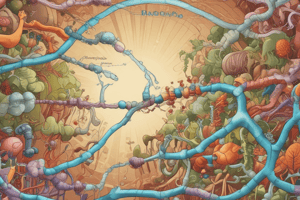Podcast
Questions and Answers
Hexokinase is regulated positively by Glucose-6-P.
Hexokinase is regulated positively by Glucose-6-P.
True (A)
Fructose-2,6-bisphosphate enhances the activity of Phosphofructokinase-1.
Fructose-2,6-bisphosphate enhances the activity of Phosphofructokinase-1.
True (A)
ATP acts as a positive regulator of the enzyme Pyruvate kinase.
ATP acts as a positive regulator of the enzyme Pyruvate kinase.
False (B)
Fructose-6-P is converted to Fructose-1,6-BP by the enzyme Phosphoglycerate kinase.
Fructose-6-P is converted to Fructose-1,6-BP by the enzyme Phosphoglycerate kinase.
Alanine acts as a positive regulator for the enzyme Pyruvate kinase.
Alanine acts as a positive regulator for the enzyme Pyruvate kinase.
Hexokinase is negatively regulated by Fructose-6-P.
Hexokinase is negatively regulated by Fructose-6-P.
Fructose-1,6-bisphosphate is a regulatory molecule for Pyruvate kinase.
Fructose-1,6-bisphosphate is a regulatory molecule for Pyruvate kinase.
Citrate functions as a positive regulator in the glycolysis pathway.
Citrate functions as a positive regulator in the glycolysis pathway.
Pyruvate kinase is irreversible in the glycolysis process.
Pyruvate kinase is irreversible in the glycolysis process.
AMP acts as a negative regulator for Phosphofructokinase-1.
AMP acts as a negative regulator for Phosphofructokinase-1.
ATP negatively regulates Phosphofructokinase-1.
ATP negatively regulates Phosphofructokinase-1.
Pyruvate kinase is positively regulated by Glucagon.
Pyruvate kinase is positively regulated by Glucagon.
Fructose-1,6-bisphosphate is a positive regulator for Pyruvate kinase.
Fructose-1,6-bisphosphate is a positive regulator for Pyruvate kinase.
The enzyme Hexokinase is regulated by the product Glucose-6-P.
The enzyme Hexokinase is regulated by the product Glucose-6-P.
Citrate acts as a positive regulator in the glycolysis pathway.
Citrate acts as a positive regulator in the glycolysis pathway.
Fructose-6-P is converted to Fructose-1,6-BP by the enzyme Phosphofructokinase-1.
Fructose-6-P is converted to Fructose-1,6-BP by the enzyme Phosphofructokinase-1.
Citrate serves as a negative regulator for Phosphofructokinase-1 in glycolysis.
Citrate serves as a negative regulator for Phosphofructokinase-1 in glycolysis.
The enzyme Pyruvate kinase is positively regulated by Fructose-1,6-bisphosphate.
The enzyme Pyruvate kinase is positively regulated by Fructose-1,6-bisphosphate.
AMP negatively regulates Phosphofructokinase-1.
AMP negatively regulates Phosphofructokinase-1.
Glucagon acts as a positive regulator for the enzyme Pyruvate kinase.
Glucagon acts as a positive regulator for the enzyme Pyruvate kinase.
Flashcards are hidden until you start studying
Study Notes
Glycolysis Regulation
- Hexokinase/Glucokinase is inhibited by its product Glucose-6-Phosphate and by Fructose-6-Phosphate.
- Phosphofructokinase-1 (PFK-1) is the rate-limiting step of glycolysis:
- PFK-1 is activated by Fructose-2,6-bisphosphate, AMP, and high levels of ADP while it is inhibited by ATP, citrate, and low levels of ADP.
- Phosphoglycerate kinase is reversible meaning it can operate in both directions of the reaction.
- Pyruvate kinase is the last step in glycolysis and is irreversible:
- It is activated by Fructose-1,6-bisphosphate which is a product of the previous step.
- It is inhibited by Glucagon, Alanine, and low levels of ATP.
Glycolysis Regulation
- Hexokinase/Glucokinase catalyzes the first step of glycolysis, converting glucose to glucose-6-phosphate.
- Regulation is allosterically inhibited by glucose-6-phosphate.
- Glucokinase in the liver is also regulated by fructose-6-phosphate.
- The second step of glycolysis, where fructose-6-phosphate is converted to fructose-1,6-bisphosphate, is catalyzed by Phosphofructokinase-1 (PFK-1).
- This is the rate-limiting step of glycolysis.
- Regulation is complex, involving several factors:
- Fructose-2,6-bisphosphate: Stimulates PFK-1 activity.
- AMP: Stimulates PFK-1 activity, indicating low energy levels.
- Citrate: Inhibits PFK-1 activity, indicating high energy levels.
- ATP: Inhibits PFK-1 activity, indicating high energy levels.
- Phosphoglycerate kinase catalyzes the conversion of 1,3-bisphosphoglycerate to 3-phosphoglycerate in a reversible reaction.
- Pyruvate kinase, in the final step, converts phosphoenolpyruvate to pyruvate in an irreversible reaction.
- Regulation is influenced by various factors:
- Fructose-1,6-bisphosphate: Stimulates pyruvate kinase activity.
- Glucagon: Inhibits pyruvate kinase activity, promoting gluconeogenesis.
- Alanine: Inhibits pyruvate kinase activity.
- ATP: Inhibits pyruvate kinase activity, indicating high energy levels.
- Regulation is influenced by various factors:
Glycolysis Regulation
- Hexokinase/Glucokinase catalyzes the first step in glycolysis, the phosphorylation of glucose to glucose-6-phosphate
- Regulation: Glucose-6-phosphate is an allosteric inhibitor of hexokinase, while fructose-6-phosphate inhibits glucokinase
- Phosphofructokinase-1 (PFK-1) is the rate-limiting enzyme in glycolysis, catalyzing the conversion of fructose-6-phosphate to fructose-1,6-bisphosphate
- Regulation:
- Fructose-2,6-bisphosphate activates PFK-1, promoting glycolysis
- AMP activates PFK-1, indicating low energy levels
- Citrate inhibits PFK-1, signaling high energy levels
- Low ATP increases the activity of PFK-1
- Regulation:
- Phosphoglycerate Kinase catalyzes the conversion of 1,3-bisphosphoglycerate to 3-phosphoglycerate, generating ATP
- Regulation: Reversible, meaning it can work in both directions based on substrate availability
- Pyruvate Kinase catalyzes the irreversible conversion of phosphoenolpyruvate to pyruvate, generating ATP
- Regulation:
- Fructose-1,6-bisphosphate activates pyruvate kinase, a feed-forward mechanism to speed up glycolysis
- Glucagon, a hormone released during low blood sugar, inhibits pyruvate kinase
- Alanine inhibits pyruvate kinase, reflecting high amino acid levels
- Low ATP increases the activity of pyruvate kinase
- Regulation:
Hexokinase / Glucokinase:
- Hexokinase: All tissues (except liver), low Km (high affinity), high Vmax, inhibited by glucose-6-phosphate
- Glucokinase: Liver, high Km (low affinity), low Vmax, not inhibited by glucose-6-phosphate, activated by fructose-6-phosphate
- Both catalyze phosphorylation of glucose to glucose-6-phosphate
- Regulation: Product inhibition by glucose-6-phosphate for hexokinase but not for glucokinase
Phosphofructokinase-1 (PFK-1):
- Catalyzes the conversion of fructose-6-phosphate to fructose-1,6-bisphosphate (committed step of glycolysis)
- Rate-limiting step: Controls the overall flux of glycolysis
- Regulation:
- Positive regulators: Fructose-2,6-bisphosphate (most potent activator), AMP (indicates low energy status)
- Negative regulators: Citrate (indicate high energy status), ATP (high concentration indicates high energy status)
Phosphoglycerate Kinase:
- Catalyzes the phosphorylation of 1,3-bisphosphoglycerate to 3-phosphoglycerate
- Reversible reaction
- Regulation: Not directly regulated
Pyruvate Kinase:
- Catalyzes the conversion of phosphoenolpyruvate to pyruvate, which is the final step of glycolysis
- Irreversible reaction
- Regulation:
- Positive regulators: Fructose-1,6-bisphosphate (feed-forward activation)
- Negative regulators: Glucagon, alanine, low ATP levels (indicate high energy status)
Studying That Suits You
Use AI to generate personalized quizzes and flashcards to suit your learning preferences.




